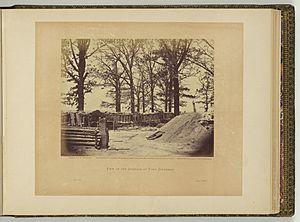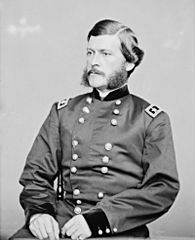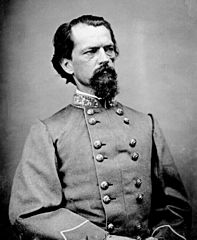Battle of Fort Stedman facts for kids
Quick facts for kids Battle of Fort Stedman |
|||||||
|---|---|---|---|---|---|---|---|
| Part of the American Civil War | |||||||
 1865 photograph at Fort Stedman by Timothy H. O'Sullivan |
|||||||
|
|||||||
| Belligerents | |||||||
| Commanders and leaders | |||||||
| John G. Parke | John B. Gordon | ||||||
| Strength | |||||||
| 14,898 | 10,000 | ||||||
| Casualties and losses | |||||||
| 1,044 total 72 killed 450 wounded 522 missing/captured |
4,000 total 600 killed 2,400 wounded 1,000 missing/captured |
||||||
The Battle of Fort Stedman, also called the Battle of Hare's Hill, happened on March 25, 1865. It was fought during the last weeks of the American Civil War. This battle was a surprise attack by Confederate soldiers. They attacked a Union Army fort called Fort Stedman near Petersburg, Virginia.
Confederate troops, led by Major General John B. Gordon, hoped to break through the Union lines. This was the last big attempt by the Confederates to end the Siege of Petersburg. At first, Gordon's attack went well. But Union troops from the IX Corps, led by Major General John G. Parke, fought back. They pushed the Confederates away, leading to a Union victory.
Contents
Why the Battle Happened
By March 1865, Confederate General Robert E. Lee was still defending Petersburg. But his army was getting weaker. Many soldiers had left, others were sick, and supplies were low. The Union army, led by Lieutenant General Ulysses S. Grant, had more soldiers. Grant had about 125,000 men, while Lee had only about 50,000.
Lee asked Major General John B. Gordon for advice. Gordon suggested three things. First, try to make peace with the Union. Second, leave Richmond and Petersburg. Then, join another Confederate army in North Carolina and fight Grant later. Third, fight right away. Lee didn't like the first two ideas much. He felt fighting was their only choice. "To stand still was death," Lee said. "It could only be death if we fought and failed."
Gordon worked hard on a plan. He decided to suggest a surprise attack on the Union lines. He hoped this would make Grant pull back his troops. It would also mess up Grant's plans to attack the Confederates. (Lee and Gordon didn't know Grant had already planned an attack for March 29).
Gordon planned to attack Fort Stedman before dawn. Fort Stedman was a Union fort in the lines around Petersburg. It was named after a Union colonel who died nearby. Fort Stedman was chosen because it was close to the Confederate lines. It also had fewer wooden obstacles protecting it. Plus, a Union supply depot was less than a mile behind the fort.
After taking Fort Stedman, Confederate soldiers would move along the Union lines. They would clear out nearby forts. This would open the way for the main attack. The goal was to reach City Point. This was Grant's headquarters and a major Union supply base.
Gordon's attack force included about half of Lee's infantry. This was about 11,500 men from Gordon's own corps and another division. Other troops were nearby or on their way. Confederate cavalry was also ready to join if the attack succeeded. The Union forces defending this area were from the IX Corps. They were led by Major General John G. Parke.
Commanders
| Opposing commanders |
|---|
|
The Battle
Confederate Surprise Attack
Gordon's attack began at 4:15 in the morning. Small groups of sharpshooters and engineers went first. They pretended to be soldiers leaving the Union army. Their job was to surprise the Union guards. They also removed obstacles that would slow down the main attack.
After them came three groups of 100 men. These men were supposed to storm the Union defenses. They carried unloaded guns so no one would accidentally fire and warn the enemy. The main attack focused on the area between two Union batteries, Battery XI and Battery X. One group went north to Battery XI, and the other two went for Battery X and Fort Stedman.
The attack was a complete surprise. Brigadier General Napoleon B. McLaughlen was the Union officer in charge of the Fort Stedman area. He heard the attack and quickly rode to Fort Haskell, south of Battery XII. He found it ready to defend itself. As he moved north, McLaughlen ordered Battery XII to fire on Battery XI. He also ordered a reserve infantry group, the 59th Massachusetts, to counterattack. They briefly took back Battery XI.
McLaughlen thought he had stopped the attack. He rode into Fort Stedman. He saw men coming over the walls and thought they were his own soldiers. He started giving them orders. Then he realized the men he was ordering were Confederates! They realized he was a Union general and captured him. McLaughlen was taken to Gordon and gave him his sword.
Gordon soon arrived at Fort Stedman. He was very happy because his attack was going better than he hoped. Within minutes, Batteries X, XI (which was retaken from the 59th Massachusetts), and XII, along with Fort Stedman, were captured. This created a gap almost 1,000 feet long in the Union line. Confederate artillery used the captured guns to fire on Union trenches.
The attack started to have trouble at Battery IX to the north. Union troops formed a battle line there. The Confederates were confused by the many trenches and couldn't attack effectively. Gordon then focused on Fort Haskell, south of his attack. He sent his division to attack it. But the Union defenders used cannons firing special "canister" rounds. These rounds were like giant shotgun blasts. They stopped the Confederate attack.
Confederate cannons from their own lines started firing on Fort Haskell. Union cannons fired back. When the Union flag was shot down, the Union gunners thought the fort had fallen. They started firing on their own men! Volunteers quickly raised the flag again. Four of them were killed before the Union cannons stopped firing.
Gordon sent a message to Lee saying the attack was going well. But he didn't know about the problems. His small groups of 100 men were lost in the rear. Many had stopped to eat captured Union food. The Confederate cavalry couldn't find a way to get through. Also, the division that was supposed to reinforce them arrived too late.
But the main Union defense was starting to get ready. Parke acted quickly. He ordered Hartranft's reserve division to close the gap. Union artillery also took positions and started shelling the Confederates.
Union Counterattack

Hartranft was determined to stop the Confederates. He worked very hard to limit their advance. By 7:30 in the morning, Hartranft had organized Union forces. They completely surrounded the Confederate troops who had broken through. They stopped them just before they reached the military railroad depot. Union artillery fired heavily on the captured forts and batteries.
Gordon, who was inside Fort Stedman, realized his plan had failed. His lead men were returning, reporting strong Union resistance. With permission from Lee, who had come to watch the battle, Gordon tried to get his forces back to safety.
By 7:45 in the morning, 4,000 Union troops under Hartranft were ready to counterattack. They formed a semicircle about a mile and a half long. A message arrived telling Hartranft to wait for more troops. But Hartranft saw that the Confederates were already wavering. He knew success was certain. So, he ordered his line to charge.
The retreating Confederates were caught in Union crossfire. They suffered many casualties. Their attack had failed. A small group from the 208th Pennsylvania recaptured Fort Stedman.
Aftermath
President Abraham Lincoln was visiting General Grant that day. A military parade was planned for the morning. But because of the Confederate attack, the parade was moved to the afternoon. A Confederate prisoner was amazed to see Grant and Lincoln so soon after the big attack. They rode by "seemingly not the least concerned." The prisoners noticed this confidence and "with one accord agreed that our cause was lost." Lincoln sent a message to the Secretary of War that morning. He said, "Arrived here all safe about 9 P.M. yesterday. No war news ... Robert [Lincoln's son] just now tells me there was a little rumpus up the line this morning, ending about where it began."
The attack on Fort Stedman lasted about four hours. It didn't change the Union lines. To make Gordon's attack strong, Lee had weakened his own right side. Union troops attacked this weaker part of the Confederate line. They captured much of the Confederate picket line southwest of Petersburg. This Union advance set the stage for Grant's big breakthrough attack a week later. This happened in the Third Battle of Petersburg on April 2, 1865.
The Union lost 1,044 soldiers in the Battle of Fort Stedman. This included 72 killed, 450 wounded, and 522 missing or captured. The Confederates lost many more, about 4,000 soldiers. This included 600 killed, 2,400 wounded, and 1,000 missing or captured.
More importantly, the Confederate positions were weakened. They lost soldiers they could not replace. After this battle, Lee's defeat was only a matter of time. His last chance to break the Union lines was gone. The Battle of Fort Stedman was the last major attack by Lee's Army of Northern Virginia. One week later, the Union Army broke through the Confederate lines. This ended the Richmond–Petersburg Campaign. Soon after, Lee's army surrendered on April 9, 1865.
See also
 In Spanish: Batalla de Fort Stedman para niños
In Spanish: Batalla de Fort Stedman para niños






